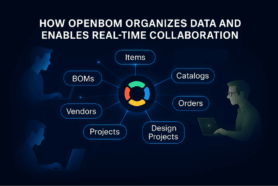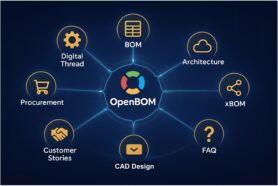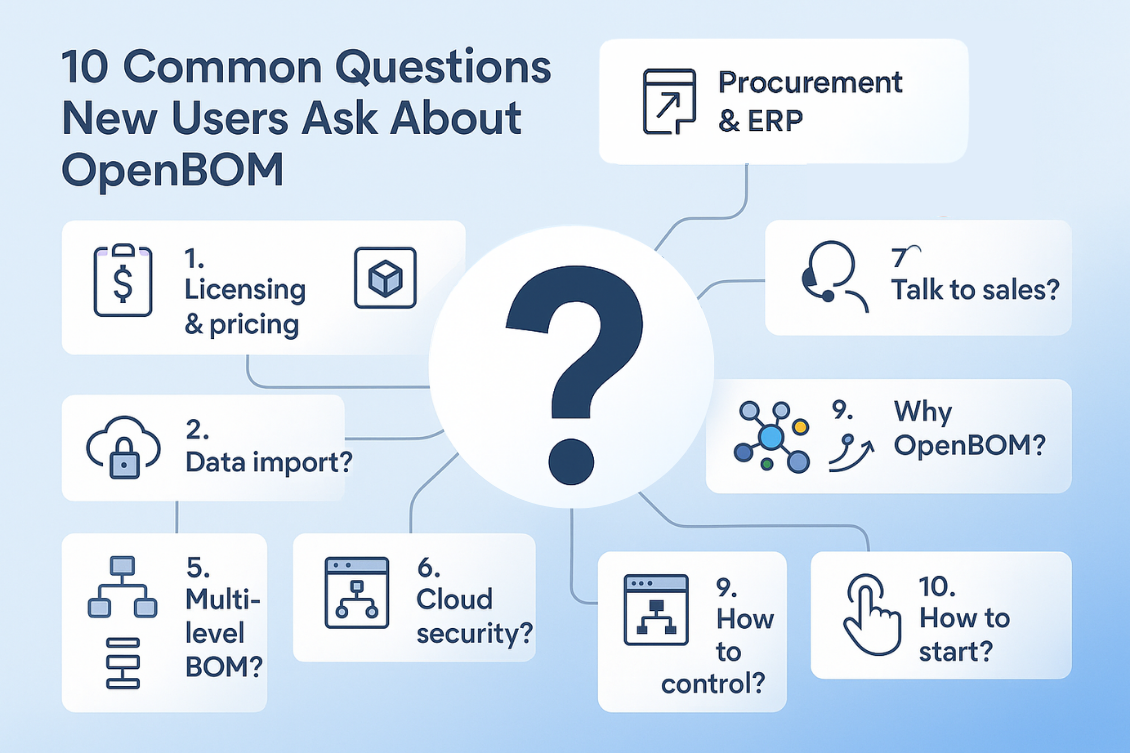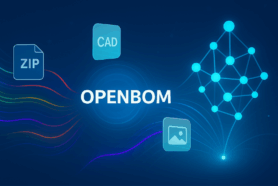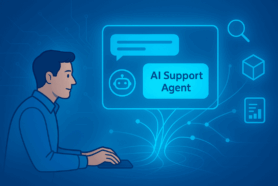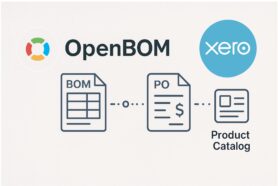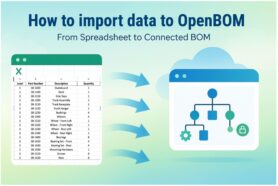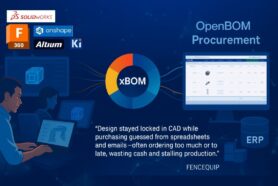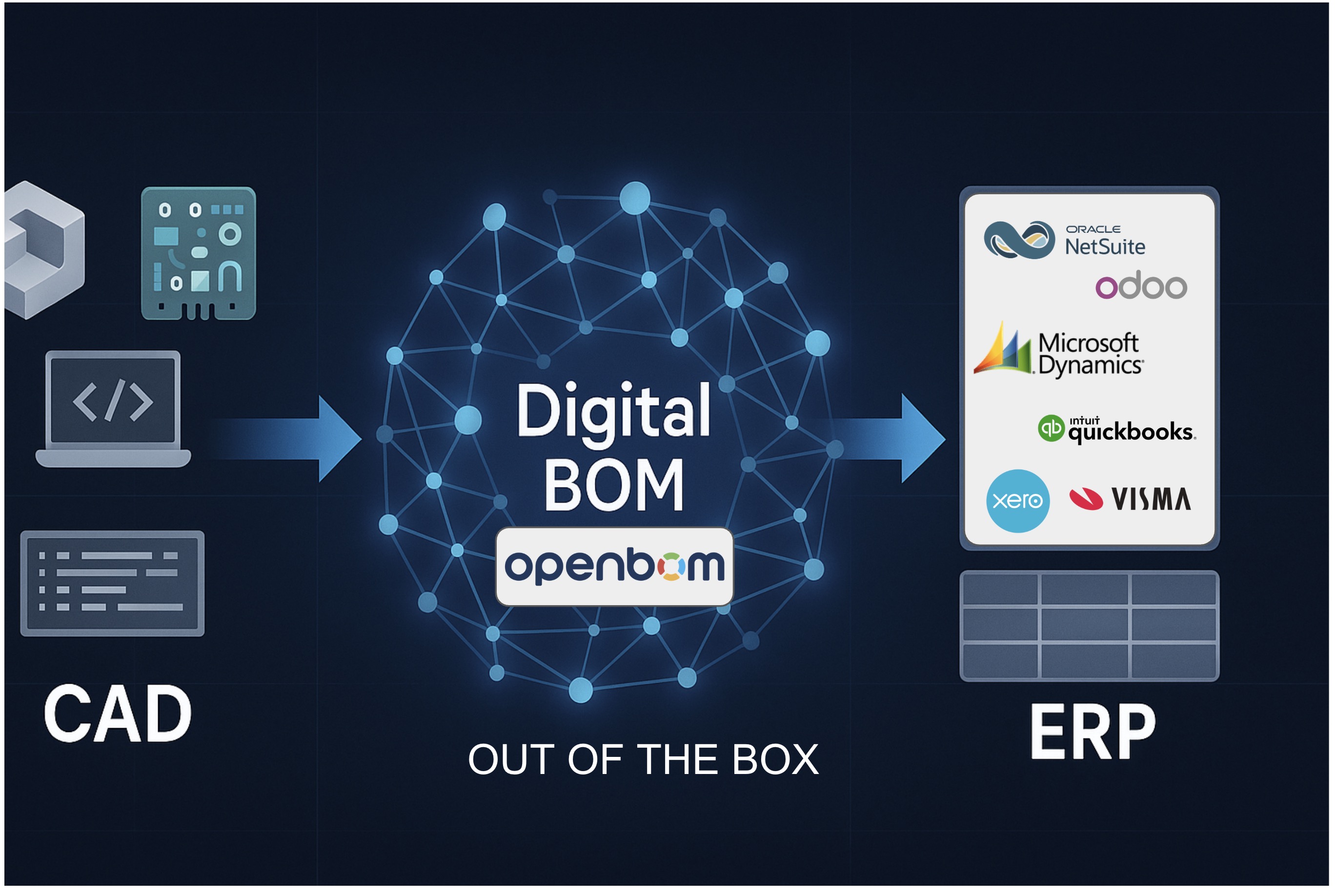
Digital BOM is a foundation of all OpenBOM to ERP integrations. From the very early days of PLM, the connection to ERP has been a high priority, and the reason is simple: companies are increasingly struggling with the disconnect between engineering design data and the operational systems that run their businesses.
In my article yesterday — The Role of the Digital BOM in Connecting CAD and ERP in 2025 — I explained why the Digital BOM has become such a critical element of modern manufacturing. It serves as the consolidated layer between engineering and ERP, capturing the growing complexity of products that now combine mechanical (MCAD), electronic (ECAD), and software components. Without such a consolidated layer, sending engineering data directly to ERP usually ends in broken integrations, manual rework, or outright failure.
The Digital BOM is more than just a list of parts. It is a structured, multi-domain representation of product data, complete with metadata, properties, and references. This makes it ERP-ready, ensuring that operational systems receive clean, consistent information about items, hierarchies, suppliers, and manufacturing requirements. OpenBOM’s mission is to streamline this process and make it accessible to teams of all sizes.
Simplicity was one of the inspirational characteristics of OpenBOM from the early days. Our technological platform allowed everyone to create an OpenBOM account within a few seconds and experience a full scope of OpenBOM production capabilities as a trial. Except… we never did an ERP integration trial. So, we asked ourselves… Why?
Out-of-the-Box ERP Interfaces – Inspired by CAD Add-ins
Our journey toward ERP integration is inspired by what we’ve already accomplished with CAD systems. Over the last few years, OpenBOM has developed robust integration technology, resulting in dozens of CAD add-ins that allow engineers to generate a Digital BOM directly from their design tools. This happens without complex configuration or weeks of IT projects. Engineers simply install the add-in, connect their design files, and within minutes, they have a structured Digital BOM ready for downstream use.
This level of simplicity has set a high bar. Engineers tell us repeatedly: “I don’t want to spend weeks mapping fields. I want to push my data out of CAD and get a BOM now.” That philosophy is now guiding our approach to ERP integration.
Instead of treating ERP connectors as big, one-off projects, OpenBOM is simplifying how to build an deliver out-of-the-box ERP interfaces. We used OpenBOM integration API and our connectors to map items, properties, and references into ERP-compatible API calls. This means catalog items, part metadata, and BOM hierarchies can flow directly into ERP systems without heavy lifting.
For example, customers using SolidWorks + OpenBOM + Odoo can already push catalog items and BOM hierarchies directly into Odoo with minimal setup. What previously required a manual setup and IT initiative now happens through a few simple clicks. Our first goal is to make OpenBOM ERP integration as effortless as OpenBOM CAD integration — starting with straightforward use cases and expanding from there.
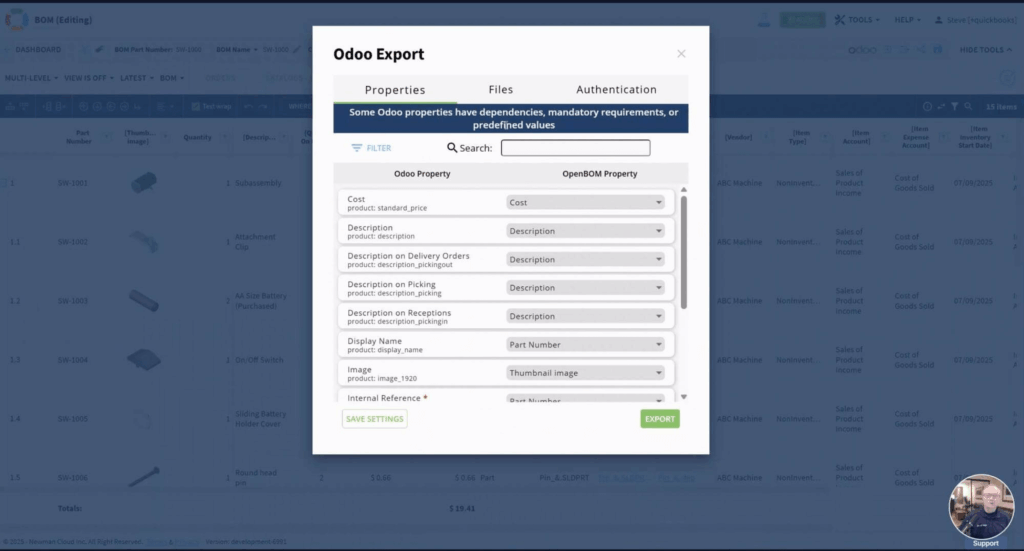
PLM to ERP – Can It Work Out-of-the-Box?
A long time ago, someone told me: “There is no such thing as an out-of-the-box ERP integration.” At the time, this was true — ERP projects were synonymous with long data-cleansing efforts, building connectors with custom APIs, reconciling data, and aligning data transmission.
But why not challenge that assumption? At OpenBOM, we believe there are pragmatic starting points where “out-of-the-box” is not only possible, but actually delivers value quickly. Especially with available modern APIs.
Traditional PLM-to-ERP integrations are still valid for large-scale enterprise deployments. They often require weeks of preparation before the first data exchange occurs. The problem is that smaller teams — or even large enterprises trying to validate a new process — cannot afford that overhead (especially because of the time). Everyone these days needs immediate, testable results.
That’s why OpenBOM focuses on quick starting points. Generating an ERP item master and a multi-level BOM sync is one such example. By exporting a well-structured Digital BOM into ERP, teams can instantly see their data flowing into operational systems. This creates a baseline to validate workflows, test purchasing processes, and uncover data gaps. Then additional configuration and adjustment can come.
Customers consistently tell us that this “start small, validate, then expand” approach works. It was proven by all OpenBOM CAD Add-in integration experience. Instead of committing to massive integration projects upfront, they can experiment with real ERP workflows using clean CAD add-in and Digital BOM data. And once those workflows prove valuable, scaling up is much easier. Needless to say – everything is available online – no installation, servers and on premise solution required.
What can be the Practical Out of the Box Flow: CAD to Digital BOM to ERP Sync
1. CAD to Digital BOM
- Using OpenBOM’s CAD add-ins (SolidWorks, Onshape, Autodesk Fusion, Altium, and many others), engineers generate a Digital BOM.
- The BOM is automatically enriched with metadata such as part numbers, descriptions, material, units of measure, suppliers, and references.
- Both MCAD and ECAD systems feed into this process, giving a multi-domain perspective that is essential for modern mechatronic products.
2. Digital BOM to ERP Sync
- The Digital BOM is then synced to ERP.
- ERP systems typically expect three things:
1) Item records (with attributes such as description, unit of measure, supplier, and manufacturer).
2) Structured BOM (assemblies, sub-assemblies and items including quantities and instance data). - OpenBOM connectors handle this mapping automatically, ensuring that ERP receives data in a compatible structure.
3. Validation and Feedback
- Once in ERP, customers can validate workflows such as procurement planning, supplier management, or cost rollups.
- Issues like duplicate part numbers or supplier mismatches are often revealed at this stage. OpenBOM provides tools to detect and resolve these inconsistencies.
We’ve already seen this process work successfully with systems like NetSuite, Odoo, QuickBooks, Visma NXT, Microsoft D365 and a few others. In each case, the immediate ROI comes from reducing manual data entry and avoiding errors when transferring engineering data into ERP. Customers report that what used to take weeks of Excel rework can now be achieved in hours.
Future AI Setup: Product Knowledge Graph to ERP
Of course, out-of-the-box ERP integration is just the beginning. The real transformation comes from applying intelligence to these processes and preparing how to turn Product Knowledge Graph and Out of the Box setup into an agentic workflow.
At the core of OpenBOM’s strategy is our Product Knowledge Graph — a graph-based data model that connects design artifacts, supplier data, and manufacturing structures. Unlike traditional point-to-point integrations, which are brittle and require manual intervention, a graph-based model is inherently more resilient and adaptive.
This architecture sets the stage for AI-driven, agentic workflows. Imagine an AI that can:
- Detect Part Number and Revision conflicts before they reach ERP.
- Suggest alternate suppliers based on availability, price, or lead time.
- Auto-complete missing ERP fields, such as units of measure or cost attributes.
- Flag duplicate items and recommend consolidation.
Instead of asking engineers or IT teams to manually fix these issues, AI can reason over the Product Knowledge Graph and make recommendations — or even automate corrections. This approach not only reduces errors but also lowers the risk of ERP integration.
In other words, the Digital BOM + Knowledge Graph + AI forms a much more intelligent and scalable way to connect PLM and ERP.
Conclusion – Try It with Us?
ERP integration has a reputation for being heavy, complex, and slow. At OpenBOM, we believe it doesn’t have to be that way. By starting small — with out-of-the-box items and BOM creation — companies can achieve immediate wins, validate workflows, and uncover gaps. From there, the path expands toward richer integrations, AI-powered reasoning, and ultimately a seamless digital thread between design and manufacturing.
We are already experimenting with customers on these out-of-the-box trials, and the results are promising. The simplicity of CAD-to-BOM workflows is now being applied to ERP, and early adopters are showing that it works.
So, do you want to try OpenBOM to ERP integration? We’d love to explore how this approach could help your team. Contact us, and let’s get started.
Best, Oleg
Join our newsletter to receive a weekly portion of news, articles, and tips about OpenBOM and our community.


